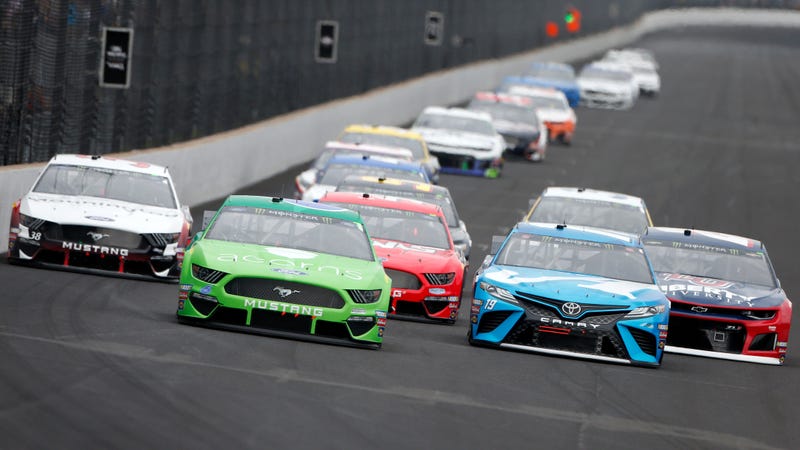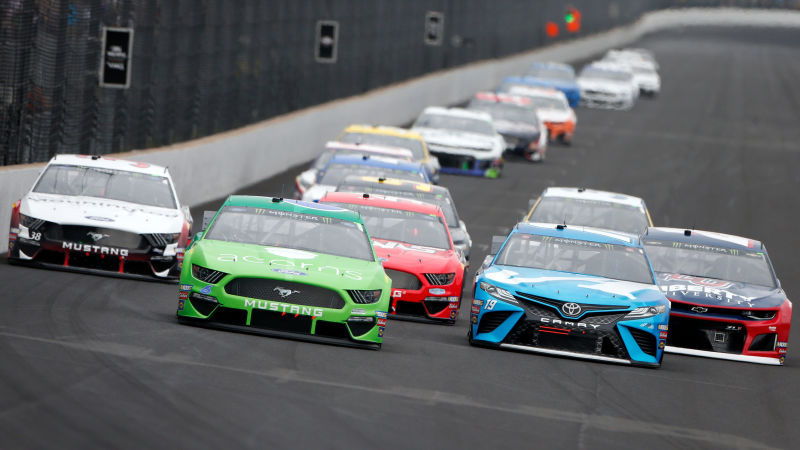
Understanding modern NASCAR can be difficult for anyone trying to get into it. You may be baffled as to why races have premeditated cautions or why they don’t just give the trophy to the driver who collects the most points, like in the old days. It gets easier with time, but like anything, it’s good to start with the basics—especially with the NASCAR playoffs upon us soon.
In the top-level NASCAR Cup Series, that kicks off Sunday at Las Vegas Motor Speedway. The playoffs mark the final 10 races of the 36-race Cup Series season, which drivers use to qualify for a spot to run for the title. Of the roughly 40-car fields, 16 drivers make it into the first playoff round, and those not going for the title often use the playoff stretch to get their cars ready for the next season.
All three NASCAR national touring series—the Cup Series, Xfinity Series and the Truck Series—now have stages and playoffs, and the rules details depend from series to series despite working from the same setup. But, again, we’re talking about the basics here, so we’ll stick to the top level.
Given all of that, let’s get to the basics of how this will work.
The Basics Of A Modern NASCAR Cup Series Race
- Modern NASCAR races have stages, each broken up with a green-and-white checkered flag and a caution period where laps count. Most races have three stages, while the Coca-Cola 600 has four.
- At the end of the first and second stages (and the third, in the Coke 600), the top-10 finishers get championship points. First gets 10 regular points and a playoff point, second gets nine points and no playoff points, third gets eight, and so on.
- At the end of each race, the winner gets five playoff points and 40 regular points. Second gets 35 regular points, and it counts down by one point per position from there. Drivers who finish 36th and lower get just one point.
- The driver who has the most points at the end of the regular season gets 15 playoff points as a bonus. This year, that driver was Kyle Busch. He leads the playoff field going into Las Vegas.
- Drivers and teams who want better track position for a restart after a stage break often use their knowledge of when the caution will happen to their advantage, opting to forego stage points in order to pit before everyone else have a higher restart position for the next green flag. For those no longer going for points or a title in the playoffs, that will be a factor.
Advertisement
How We Got Here
- The regular season is, again, the first 26 Cup Series races of the year, while the final 10 make up the playoffs. Along the way, there are a lot of ovals and two road courses: Sonoma Raceway and Watkins Glen.
- A race win during the regular season almost guarantees a driver a spot in the playoffs, aside from a couple of rules to insure that someone doesn’t win the first race of the year and then park their car until September. In cases of injury, like Busch’s Daytona crash in 2015 that sidelined him for 11 races before he came back and won the title, medical waivers can be given.
- For playoff spots not given out as a result of race wins, the final places are filled in by points. This season, the top 10 drivers who qualified for the playoffs have won a race and the bottom six have not.
- The standings heading into the playoffs, in order, are: Kyle Busch; Denny Hamlin; Martin Truex Jr.; Kevin Harvick; Joey Logano; Brad Keselowski; Chase Elliott; Kurt Busch; Alex Bowman; Erik Jones; Kyle Larson; Ryan Blaney; William Byron; Aric Almirola; Clint Bowyer; and Ryan Newman. Kyle Larson is the first driver on that list to have not won a race this year.
Advertisement
The Logistics Of The Playoffs
- The playoffs last 10 races, and they’re broken up into four segments. The first three segments are each three races long, and the final segment is one race. This year, the final race of the season is at the 1.5-mile Homestead-Miami Speedway in Florida.
- Of the 10 races, four of them take place on 1.5-mile ovals, which are the most popular track type on the schedule. There are four race tracks shorter than that—Richmond Raceway, Dover International Speedway, Martinsville Speedway and ISM Raceway in Arizona—and one superspeedway, which is Talladega.
- The other race, Charlotte Motor Speedway, was run on the 1.5-mile oval up until last year, when NASCAR began running the roval in order to put a road course into the playoffs without changing the schedule.
- Next year, the final race will be at the mile-long ISM Raceway, meaning the title decider will take place on a different style of track than it currently does. The move shows the inherent flaws of a one-race title system.
Advertisement
How NASCAR Decides Its Champion
- A win in one round of the playoffs automatically advances a driver to the next round—so long as they don’t get disqualified, in which case the win and the perks of it go to the next legal car—and the rest of the spots are filled by points, similar to how drivers make the playoffs in the first place.
- First round of the playoffs: three races, 16 drivers. The bottom four drivers are eliminated from title contention at the end.
- Second round of the playoffs: three races, 12 drivers. The bottom four are eliminated from title contention at the end.
- Third round of the playoffs: three races, eight drivers. The bottom four are eliminated from title contention at the end.
- Fourth round of the playoffs: one race, four drivers. The highest finisher in the race wins the championship, so long as they’re not disqualified in post-race technical inspection. Points don’t matter in the final race in terms of deciding the title winner, only that they’re ahead of the other three in the finishing order.
Advertisement
Drivers To Watch This Year
Picking a champion under the current NASCAR rules system is near impossible, as the entire season ends with one race, four drivers on an even field, and the potential for anything to happen. A parachutist could hit a contending race car minutes before the start of the race and cause aerodynamic strain, for example, or the favorite to win could wreck on the first lap.
Advertisement
But while picking a champion is a futile effort, it is easy to assume who will most likely be around at the end.
- Kyle Busch: While he hasn’t been as dominant in recent races, Busch is tied with Hamlin and Truex for the most wins of the season at four and, under the new elimination system, tends to be around at the end.
- Kevin Harvick: Harvick is the opposite of Kyle Busch, having a slow start to the season but picking up to win three races thus far. He’s a usual suspect to be around at the end, and likely will be this year as well.
- Martin Truex Jr.: He’s consistent, he’s tied for the most wins of the year so far, and he knows how to make it to the end of the playoffs.
- Aside from the so-called “Big Three” from 2018, all of whom have won Cup championships, that final championship spot for Homestead is hard to call. It’ll probably be a tossup between Hamlin and Logano, and, if we’re betting here, Keselowski will likely be contention as well but get cut at the end of the third round.
Advertisement
None of that includes the little intricacies in how the championship, like how playoff points differ from regular points or the conundrum of what will happen if all four championship contenders take each other out in the same wreck in the final race of the season.
Advertisement
But, as advertised, this is a very basic guide to the playoffs, and that kind of stuff graduates into the “not very basic” realm. If you want the challenge, there are links below to help you take it up.















